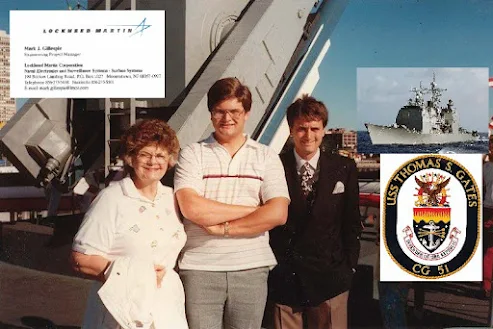Happy Memorial Day. The photos below are of my family members who served in the U.S. Armed Forces. L to R, my mother Penny Gillespie, my brother Mark Gillespie, and me, Neil Gillespie, standing by the Mark 26 missile launcher on the aftdeck of the USS Thomas S. Gates, a Ticonderoga class guided-missile cruiser at the commissioning ceremony August 22, 1987 in Philadelphia, PA.
My maternal grandfather John Diver (1896-1956) enlisted in the Army near the end of WWI. A baker by trade, he served four months as a cook to a Captain. John Diver was stationed stateside in Company 45, 153 Depot Brigade. Grandpa Diver was honorably discharged on January 4, 1919. My grandfather died the year I was born, so I did not know him. In 2015 my Uncle Jack told me John Diver's mother, Martha Diver, was Jewish. John Diver's father, Joseph Diver, was Irish Catholic. The 1910 census shows my grandfather was an orphan by then. After WWI John Diver was a baker for the Keebler cookie company in Philadelphia.
My Uncle Jack, John "Jack" Diver (1927-2017) served in the Navy during WWII aboard the USS Teton, an amphibious force command ship, during the Battle of Okinawa. Jack Diver was in Tokyo Bay on September 2, 1945 for the surrender of Japan. After his honorable discharge, Uncle Jack worked in Washington, D.C., as a representative for the Lathers Union now part of The United Brotherhood of Carpenters. I witnessed first-hand how unions can benefit families and society. As I wrote previously, I believe it is time for a People's union to support nonlawyers who appear pro se in court. A People's Bar in order for nonlawyers to get a fair day in court as required by the Constitution and laws of the United States, and of Florida and the other states.My father, Cornelius "Neil" Gillespie (1928-2002), was a Sergeant in the U.S. Army, stationed in Hanau, Germany (1951-1953) and stateside in the reserves until 1957. By the luck of a coin toss Dad was spared Korea. My father attended the Adjutant General’s School, Fort Benjamin Harrison, Indiana, where he was trained to use a computer for inventory control for the Army Corps of Engineers. Dad was honorably discharged January 3, 1957. My father worked for Keystone Insurance Company in Philadelphia (1946-1966) initially in the mail room, and in computer operations after returning from active duty.
My parents met while working at Keystone, married in 1955, and moved to Levittown, PA. Dad was the data processing manager for Bayuk Cigars in Philadelphia from 1966-1975. (Honeywell 200 mainframe). When Bayuk moved its operations to Fort Lauderdale, Florida, my father left the company and stayed in Levittown, and worked for other companies in the Philadelphia area, as a programmer, computer systems analyst, a computer operator (IBM System/370 mainframe) and had non-computer jobs, including sales, and title clerk for my business, Kar Kingdom in Langhorne, PA.
My brother Mark Gillespie (1958-2022) was a Sergeant in the U.S. Air Force (1976-1980) and trained on the AWACS surveillance plane. After his tour of duty ended, Mark worked for Lockheed Martin as an Engineering Project Manager. In Moorestown, New Jersey, Mark managed the Naval Electronics and Surveillance Systems (Surface Systems) for the Aegis guided missile cruiser USS Thomas S. Gates. The photo shows my mother Penny, Mark, and me, on the deck of the USS Thomas S. Gates at the commissioning ceremony August 22, 1987 in Philadelphia. Mark's career with Lockheed Martin later took him to Fort Worth, Texas, where he was a Project Manager on the F-16 Fighting Falcon.
Mark's wife of 40 years, Jody, was in the U.S. Navy, trained as an aviation hydraulics mechanic. Jody was based in Beeville, Texas and Keflavik, Iceland for most of her tour of duty. Jody was in the Navy about a year ahead of the time Mark was in the Air Force, and got out of the military sooner than he did. Jody was from a military family. Her Dad's work for the military kept them moving across Europe and North Africa most of her childhood and teenage years.
In 1974 I registered with the Selective Service System after I turned age 18, but was not drafted. (Left, my high school graduation photo, 1974*). Wikipedia notes, "Active conscription in the United States ended in January 1973, and the U.S. Armed Forces moved to an all-volunteer military except for draftees called up through the end of 1972." This coincided with the draw down of the Armed Forces preceding the end of the Vietnam War on April 30, 1975. In 1990 during the buildup to the Gulf War, I sought to enlist at the recruiting office on Germantown Avenue at North Broad Street and Erie Avenue in Philadelphia. This recruiting office was just a few blocks from my business on West Erie Avenue, Joe's Erie Ave. Auto Sales. After graduating from Penn a year earlier, I planned to enlist with my new degree and go to Officer Candidate School. But I learned an old injury to my right ankle prevented me from enlisting. In 1976 orthopedic surgery to repair a broken ankle left me with a large metal screw in my foot to hold the bones together. An attorney I consulted at the time thought I might successfully contest this disqualification, but my age was another issue. In 1990 I was age 34, with about six months left before I turned 35, the age limit to enlist at that time. (* When the photo was taken at Bishop Egan Catholic High School in Fairless Hills, PA, the photographer told me he would air-brush out my cleft lip facial scar to make me look better, which is reflected in the final image.)
Subsequently I learned a speech impairment affecting the ability to repeat commands is grounds for 4-F military medical disqualification. Also cleft lip or palate defects, unless satisfactorily repaired by surgery, can be 4-F disqualification. Traumatic brain injury from August 20, 1988 was also grounds for 4-F disqualification in appointment, enlistment and induction, although I was not accurately diagnosed at that time.









